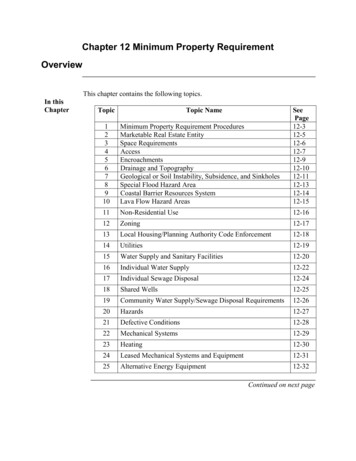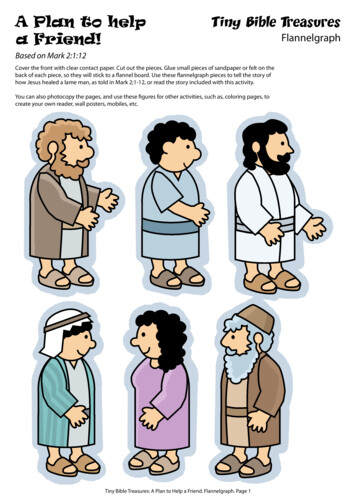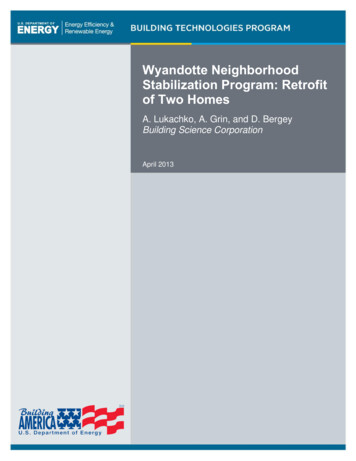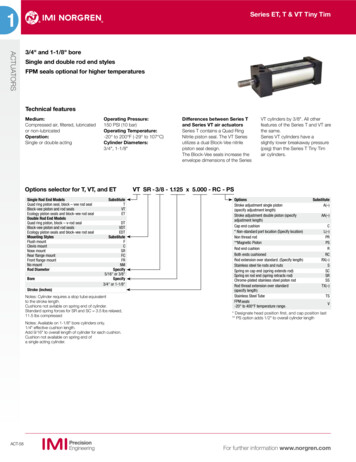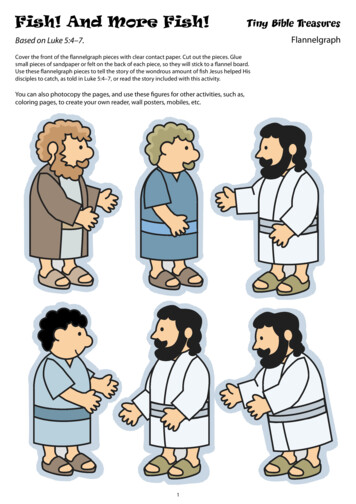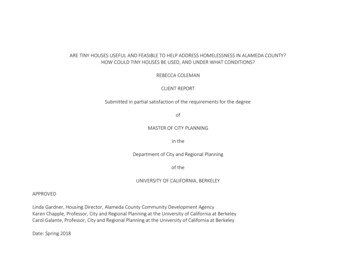
Transcription
ARE TINY HOUSES USEFUL AND FEASIBLE TO HELP ADDRESS HOMELESSNESS IN ALAMEDA COUNTY?HOW COULD TINY HOUSES BE USED, AND UNDER WHAT CONDITIONS?REBECCA COLEMANCLIENT REPORTSubmitted in partial satisfaction of the requirements for the degreeofMASTER OF CITY PLANNINGin theDepartment of City and Regional Planningof theUNIVERSITY OF CALIFORNIA, BERKELEYAPPROVEDLinda Gardner, Housing Director, Alameda County Community Development AgencyKaren Chapple, Professor, City and Regional Planning at the University of California at BerkeleyCarol Galante, Professor, City and Regional Planning at the University of California at BerkeleyDate: Spring 2018
Executive SummaryAlameda County is experiencing a homelessness crisis, and interest in tiny houses as a possible and limited way to address the issue is increasing. Whileover a dozen tiny house villages have been developed across the U.S. to address homelessness, questions remain about the extent to which they arehelpful in Alameda County, a high density and costly region.This report explores the application of tiny houses to Alameda County by providing background information about tiny houses for homeless individuals,including a brief history of tiny houses in the U.S. and the contemporary tiny house movement. The report next discusses the tiny house for homelessvillage model, including components of a successful village, challenges and opportunities for tiny house villages, and recent legislation and trends.Applications of the model are discussed, including micro-apartments, Accessory Dwelling Units (ADUs), and mobile homes. Finally, case studies of tinyhouse projects that are developed or underway in Oakland, Berkeley, and Hayward are presented.Entities pursuing tiny house projects tend to be civically-minded and entrepreneurial, acting urgently to take matters into their own hands to help theirunsheltered neighbors. This report finds that well-planned tiny house projects could be supported through specific changes to local zoning andpermitting processes as a way to complement other ongoing efforts to address homelessness. The report investigates the following four questions, withfindings summarized beneath each question:How are tiny houses useful to help address homelessness in Alameda County? An insufficient amount of alternative housing exists for homeless individuals.Units are built in compliance with local and federal building standards.A local entity (either municipal, nonprofit, faith-based, or private citizen) is willing and able to put in the leg work.Support services are provided in either a transitional or permanent housing model to integrate the individuals into the community. If the housingis transitional, there must be placement to more stable housing options.Outreach to sheltered neighbors takes place so that the homes are integrated into the broader community.How can tiny houses be feasible to help address homelessness in Alameda County? A recent change to the California Building Code creates new minimum standards for emergency housing that significantly reduce the barriers tobuilding tiny houses for homeless people. This change is significant because outside of these new minimum standards, tiny houses either need tocomply with state building codes meant for conventional single family homes or to comply with RV standards – both of which can be prohibitiveand out of scale with these projects. To invoke the new emergency standards a local ordinance must be passed declaring an emergency housingcrisis along with adopting the new emergency building standards, and a local re-zoning may be necessary.Development in high density/high cost areas is feasible when the development is infill, built on land that is already underutilized, or builtprovisionally on land that is owned or leased by a city to bring more services to an encampment.1
Tiny house villages, typically comprised of free standing detached units, are frequently able to reduce startup capital costs by acquiring land at areduced cost and attracting sweat equity to build units.Operating costs are frequently reduced through a combination of grants from foundations and private individuals, micro-enterprises, federalsubsidies, and regular chores performed by residents.What characteristics make tiny house communities successful, as shown by examples of successful developments? Common buildings with shared facilities, including a kitchen, laundry, showers, and portable toilets, both provide opportunities for morecommunal living and supplement the low square footage of individual units.Most villages offer residents support services, including case management, dental and health care, behavioral health, workforce development,workshop and support groups, and transportation.Many villages provide transportation, either by arranging for a bus to come to the community, or locating their community close to publictransportation (1/8 to half of a mile). Many villages operating throughout the country are either 1-3 miles from or within the city center, withonly a few villages 4-10 miles away from the city center.Residents typically undergo a selection and approval process, either through a coordinated entry process (qualifying under HU D’s definition ofchronically homeless), application and intake process (a process that can include a background check, medical questionnaire, skills and educationinventory, sweat equity, and/or participation in membership meetings) and/or referral by agencies, religious leaders, and community members.What specific changes to local zoning, design, and permitting processes would make it more efficient to build tiny housesfor homeless individuals in Alameda County? The Alameda County Board of Supervisors recently declared a shelter crisis in Alameda County. Alameda County should take the next step andadopt the new emergency housing minimum standards that were added as an appendix to the 2016 California Building Code and 2016 CaliforniaResidential Code that significantly reduce the barriers to building tiny houses for homeless people.California State Housing and Community Development (HCD) should consider developing and adopting building code standards that are uniqueto tiny houses rather than applying existing building standards to tiny houses.Emergency housing should be permitted in more zoning districts. In Alameda County, the General Ordinance Code currently allows foremergency housing only in the R-4 multiple residence district.Additional parcels that can be zoned as mobile home parks should be identified.Permit fees should be waived for groups that want to build tiny house villages, including: building, zoning, planning, inspection, and dumpingfees. Costs associated with these fees can make a project with a relatively small budget cost prohibitive or are unduly disproportionate to thetotal budget. Parking, open space, and lot coverage requirements should be waived as well because many of these requirements do not apply tothe scale of tiny house village developments.A manual showing best practices for tiny house implementation, including evaluation metrics, staffing, construction, and design, should bedeveloped and implemented to make the process of building tiny houses more efficient.2
AcknowledgementsI was encouraged to work on issues related to homelessness from my experiences growing up in a reform Jewish congregation in Los Angeles. Our rabbiwould organize dinners to serve food to homeless people in a nearby park. We had many conversations with the people we were sharing food with andwe talked about the importance of Tikkun Olam, which translates to “repair the world.” While an undergraduate at UC Berkeley, the opportunity to takea course from Helaine Kaplan Prentice and then work as a research assistant at Karen Chapple’s Center for Community Innovation showed me that cityand regional planning was a path that I could take to work on housing issues as a professional.Thank you very much to Linda Gardner for assigning me this project, which has been so interesting to work on because it presents an alternative solutionto addressing a problem with no clear or easy answers. Linda provided feedback on multiple drafts beyond my summer internship at the Alameda CountyCommunity Development Agency’s Housing and Community Development Department, allowing me to develop a much more extensive report.Additionally, my colleagues at the Alameda County Community Development Agency provided useful feedback and encouragement while I worked in theoffice over the summer: Jim Bergdoll, Christine Cherdboonmuang, and Carolann Perales.My advisors Karen Chapple and Carol Galante provided thoughtful feedback multiple times on the direction of the report. I especially owe thanks toMiriam Zuk for providing valuable feedback throughout the writing process.Emily Pilloton, who taught an undergraduate studio in the UC Berkeley College of Environmental Design focusing on similar questions, invited me to joinseveral invaluable field trips to organizations working on building tiny houses in Berkeley and Oakland. These field trips allowed me to see firsthand theways that organizations are taking matters into their own hands to help our community. Thanks also to Manuel Corona, an undergraduate in Emily’sclass, for coordinating trips to and information-sharing on Oakland’s Outdoor Navigation Center.Many cities in Alameda County responded to the information requests assessing city level interest in tiny houses, which enhanced my understanding ofcivic receptiveness to tiny houses. I am also grateful to the representatives of tiny house communities across the U.S. who responded to my survey tobetter understand current practices of tiny house communities that serve homeless households. The following individuals also provided invaluableinformation for this report: Sally Hindman of Youth Spirit Artworks; Matthew Wolpe, a faculty member in the Carpentry Department at Laney College inOakland; Tom Flemming, a tiny house developer in Hayward; Jerry Wilburn, a Masters of Urban Planning graduate student at San Jose State Universityand intern at the City of San Jose Department of Housing; and Daniel Barth, a local homeless advocate.My friends and colleagues Kate Beck and Sarah Skenazy joined me on more than a couple marathon writing sessions while we each worked on ourreports. I also owe thanks to William Coleman and Kenny Meyer for their incisive comments, Shaon Barman for thoughtful feedback, Alfred Twu forbrainstorming creative ideas, Joe Poirier for being a levelheaded critic, and Anna Cash for sharing additional resources. My wonderful housemates copyedited sections of the report before I submitted the final draft: Heidi Bartlett, Ari Chivukula, David Faulkner, and Rachel Hestrin.Thank you to my partner Jonathan Irving Kelly for discussing this report with me countless times and for encouraging me to be bold. And finally, thankyou to my mother Deborah Teltscher for her inspiration and support.3
Table of ContentsIntroduction . 6Background on Tiny Houses for the Homeless. 12“Housing First” Philosophy . 12Brief History of Tiny Houses in the U.S. . 13Hooverville Shanty Towns and Tent Cities. 13Single Room Occupancy (SRO) Hotels and Micro-units . 15Contemporary Movement: Downsizing versus Upsizing. 16Tiny House Nation . 17Tiny Houses for the Homeless Village Model. 19Components of a Successful Village . 19Challenges and Support for Tiny House Villages . 22Recent Legislation and Trends . 23Tiny House Villages for the Homeless: U.S. Timeline. 24Trend Across California. 25Recent Regulatory Changes in California. 27Alameda County Case Studies . 31Oakland . 31“Tuff Sheds” Outdoor Navigation Center at 6th and Castro Streets, Oakland, CA . 31Laney College, Oakland, CA . 37Berkeley . 38Youth Spirit Artworks (YSA), Berkeley, CA . 39Hayward. 44A tiny house community in a backyard, Hayward, CA . 45Unincorporated Alameda County . 47First Presbyterian Church, Castro Valley, CA . 47Applications of the Tiny House Model . 49Asking the Right Questions about Tiny Houses . 49Safe Organized Spaces (SOS!) . 50Micro-Apartments . 52Accessory Dwelling Units. 534
How are Tiny Houses Different than Mobile Homes? . 54Recommendations . 57What specific changes to local zoning, design, and permitting processes would make it more efficient to build tiny houses for homelessindividuals?. 57What are some additional considerations that Alameda County might want to explore around implementation? . 57Works Cited. 59Appendices . 64Appendix A: Full Survey Results: Survey of Tiny House Communities that Serve Homeless Households . 64Appendix B: Bay Area Safe Organized Spaces Select Planning Group Regional Landscape Scan . 126Appendix C: Request Letter: Alameda County Tiny Houses Study Information Request . 136Appendix D: Full Response Results: Alameda County Tiny Houses Study Information Request . 138Table of FiguresFigure 1. 2009-2017: Alameda County Homeless Population Increase. Source: . 6Figure 2. Tiny House Types . 7Figure 3. Tiny Houses Movement versus Tiny houses for the Homelessness. 17Figure 4. U.S. Tiny House Villages for Homeless Timeline . 24Figure 5. City of Oakland Plans for 6th and Castro Lot. . 36Figure 6. Youth Spirit Artworks Prototype Construction Set Cover Sheet. . 42Table of MapsMap 1. Tiny Houses for the Homeless in California: Planned and Existing as of 2018 . 26Table of ImagesImage 1. Tuff Sheds at 6th and Castro Streets, Oakland, CA. February 26, 2018. . 33Image 2. Youth Spirit Artworks Tiny House Prototype, Berkeley, CA. February 14, 2018. . 41Image 3. Tom Flemming in his tiny house prototype. Hayward, CA. April 11, 2018. 465
IntroductionAlameda County is experiencing a homeless crisis. According to the 2017 homeless census there are 5,629 homeless people inAlameda County, 69% of whom are unsheltered.1 While the census provides a point-in-time snapshot, 2-3 times more peopleexperience homelessness during the course of a year, based on data in the Homeless Management Information System (HMIS). Figure1 below, taken from the 2017 homeless census, shows that the homeless count for Alameda County is at its highest point since 2009.Additionally, there was a large increase in homelessness between 2015 when the homeless count was 4,040 compared with 2017.Figure 1. 2009-2017: Alameda County Homeless Population Increase.Source: 2017Alameda County Everyone Counts Homeless Point-in-Time Count and Survey. Retrieved April 2018 from: ALAEMDA 7-1.pdfThe scale of the crisis demands that we develop innovative, solutions-oriented proposals to address this problem. A broad range ofefforts aimed at creating tiny housing to address homelessness have cropped up across Alameda County. Some efforts include TuffShed shelters in Oakland, development of tiny houses in the backyard of a private citizen in Hayward, a nonprofit that is pushing fortiny houses for homeless youth in Berkeley, and a proposal to build six tiny houses on a church’s property in unincorporated AlamedaCounty. A common theme of all of these approaches is that they are ad hoc and resourceful. Many efforts are also grass roots.There is not a single, agreed upon definition of what a tiny house is in common use and the term is increasingly used to mean manydifferent types of structures. In vernacular use, tiny houses could refer to any of the following house types:2017Alameda County Everyone Counts Homeless Point-in-Time Count and Survey. Applied Survey Research. Retrieved April 2018 17/06/ALAEMDA 7-1.pdf16
Makeshift SheltersInformal shelters madefrom found materials byWest Oakland artist.Accessory DwellingUnitSmall cottage inbackyard that islegally part of sameproperty as mainhome.Tiny House on WheelsComplies with existingcode for trailers and RVs.“Tuff Shed”-likeSheltersFresno providestransitional housing ina villageconfiguration.Micro-apartmentsIncludes small studios orone-bedroom apartmentsand SRO units withcommunal spaces.Figure 2. Tiny House TypesThere is currently no statutory or regulatory definition for tiny houses in California. The California Department of Housing andCommunity Development (HCD) allows for a variety of structures to be defined as a tiny house as long as they fall between 80 and 400square feet in size. The definition comes from an informational bulletin issued in May 2016 that sought to “clarify the legality of use,design and construction approval of any residential structure that may be commonly referred to as a tiny house.”2A Recreational Vehicle (RV), Park Trailer (PT), Manufactured Home, Factory-Built Housing, or Camping Cabin, could then all beconsidered a tiny house. But depending on their construction, the house would be subject to different regulatory requirements or fallunder the jurisdiction of another agency. For example, the CA HCD memo states that structures built on a chassis with wheels do notfall under the CA HCD’s jurisdiction. If the tiny house is placed on a permanent foundation then it must comply with California building“Tiny houses” Information Bulletin. California Department of Housing and Community Development. May 9, 2016. Retrieved April 2018 from:http://www.hcd.ca.gov/docs/IB2016-01.pdf.27
codes and standards.3 Recent CA building code and State Assembly legislation that eases the way for tiny houses will be discussedlater on in the report in the “Recent Regulatory Changes in California” section. Locally, the absence of a clear definition of tiny houseshas resulted in some efforts to get around permitting and zoning codes through requesting conditional use permits or overlay zoning.Free standing detached tiny houses represent a partial solution to address homelessness. Nevertheless, they are being taken up as a“do-it-yourself” strategy by enterprising and civically minded people because they are cheaper and faster to construct than typicalaffordable housing on a per unit basis. For example, BRIDGE Housing’s 2016/2017 Annual Report shows an average development costper unit of 626,900 for affordable housing developments in San Francisco (development costs include construction cost andconstruction interest, land/infrastructure, architecture and engineering, legal, and the developer’s fee). The per unit capital costs ofunits in tiny house villages tend to range from below ten thousand dollars to one hundred thousand dollars, as illustrated in Table 1below that breaks out capital and operating costs for three examples.Of course, the cost of building units cannot be considered in a vacuum: one most also consider other costs associated withdevelopment. Other costs can include whether the land is owned upfront or must be purchased, construction type and materials,whether there is electricity and other utilities onsite, and there are often additional considerations. An important difference betweenAlameda County and the cities profiled in Table 1 showing costs for tiny house villages in Eugene, Oregon and Olympia, Washington isthat they are lower density in terms of population per square mile than about half of the cities in Alameda County. It is also importantto note that two out of the three villages are built on land that was either city or county owned, although Emerald Village is built on1.1 acres of land was purchased for 281K.4 A more extensive breakdown of costs based on a survey of eleven tiny house villages andprograms across the U.S. conducted for this report during the summer of 2017 will be discussed later in the “Tiny Houses forHomeless” section of this report.“Tiny houses” Information Bulletin. California Department of Housing and Community Development. May 9, 2016. Retrieved April 2018 from:http://www.hcd.ca.gov/docs/IB2016-01.pdf.4 “It Takes a Community to Raise a Village.” Square One Villages. June 2017. Retrieved April 2018 from:https://docs.wixstatic.com/ugd/bd125b 3f934416b8fa48ea965c85f015d546dd.pdf.38
Table 1. Tiny House Example Capital and Operating CostsSource: Adapted from “Making a Tiny Deal of It: A Feasibility Study of Tiny house Villages to Increase Affordable Housing in Lane County, Oregon,” by Sara Abarbanel, CassandraBayer, Paloma Corcuera, and Nancy Stetson, Goldman School of Public Policy. May 2016. Retrieved April 2018 from:http://media.wix.com/ugd/bd125b 211036cceef7432aa1e7108f934db279.pdfTiny houses are on many people’s minds: local elected officials, private developers, and homeless advocates. In Alameda County, tinyhouses were frequently brought up during the A1 bond measure planning process – an affordable housing bond that passed in fall2016 to raise 580 million to provide affordable local housing and prevent displacement of vulnerable populations, including low- andmoderate-income households, veterans, seniors, and persons with disabilities; provide supportive housing for homeless peoplecountywide; and help low- and middle-income households purchase homes and stay in their communities. Before that in 2014, a U.S.Housing and Urban Development (HUD) spokesperson described tiny houses as an important step to providing assistance to homeless9
individuals: “It’s certainly something that we should encourage other communities to take a look at when it comes to creatingsolutions for housing the chronically homeless. It’s a very important step in terms of the kinds of services we should be providing topeople the need assistance.”“It’s certainly something that we should encourage other communities to take a look at when it comes tocreating solutions for housing the chronically homeless. It’s a very important step in terms of the kinds ofservices we should be providing to people that need assistance.”– Lee Jones, Regional Public Affairs Officer, U.S. Department of Housing and Urban Development,reported by Yes! Magazine on February 20, 20145At the same time that tiny houses are gaining popularity, there are pros and cons to consider whether, when, what, and where tinyhouses are an appropriate response to homelessness. In 2016, the U.S. Interagency Council on Homelessness raised a list of issues toconsider when evaluating tiny houses as a response to homelessness that will be discussed later on in the “Asking the Right Questionsabout Tiny houses” section of this report. Additional questions raised by housing advocates around tiny houses include whether theyare too tiny to be comfortable or healthy; whether they are consistent with the character of neighborhoods; whether in oururbanized, high land cost areas, tiny houses are an efficient use of land to address housing and homeless housing needs; whether theyare a scalable model; and whether they are politically feasible.This report will address these questions by discussing best practice characteristics of successful models and will also discuss possiblelimitations of the model specific to Alameda County. The report focuses on free-standing tiny houses for transitional and permanentsupportive housing for unsheltered homeless individuals, and also discusses three additional types of housing as applicatio
adopt the new emergency housing minimum standards that were added as an appendix to the 2016 California Building Code and 2016 California Residential Code that significantly reduce the barriers to building tiny houses for homeless people. California State Housing and Community Deve

